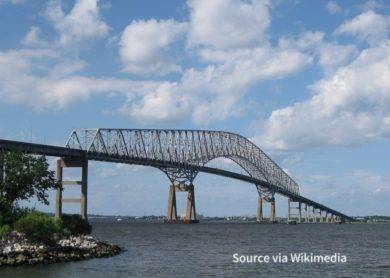In a devastating turn of events, the Francis Scott Key Bridge in Baltimore collapsed into the Patapsco River after being struck by a large cargo vessel, setting off a frantic search for six missing construction workers. The incident, which occurred around 1:30 a.m., sent shockwaves through the city and disrupted crucial shipping routes along the East Coast.
Authorities revealed that the collision was preceded by a distress call from the vessel’s crew, who reported a power issue moments before impact. Dramatic footage captured the cargo ship colliding with one of the bridge’s columns, causing it to crumble into the river below. Flames and smoke billowed into the night sky as the Francis Scott Key bridge collapsed, trapping several vehicles and workers on the structure.
Maryland Transportation Secretary Paul Wiedefeld disclosed that the bridge was undergoing repair work at the time, with contractors on-site to address maintenance issues. Sadly, the collapse resulted in multiple vehicles plunging into the icy waters of the Patapsco River, posing additional challenges for rescue teams due to the risk of hypothermia. As of now, only two individuals have been rescued, with one in critical condition, underscoring the severity of the situation.
Desperate Search and Rescue Efforts
In the aftermath of the Francis Scott Key bridge collapse, a massive search and rescue operation swung into action, with emergency responders racing against time to locate the missing construction workers. Despite the daunting challenges posed by the frigid temperatures and treacherous conditions, teams from the Baltimore City Fire Department and other agencies worked tirelessly to comb through the wreckage and debris strewn across the river.
Chief James Wallace of the Baltimore City Fire Department provided updates on the situation, revealing that efforts to assess the damage to the cargo vessel were underway before rescuers could attempt to board it. The vessel, which belonged to the major shipping company Maersk and was en route to Sri Lanka, remained a focal point of the operation as authorities sought to ensure the safety of its crew and assess the extent of the damage caused by the collision.
As the search continued into the night, authorities urged caution and patience from the public, emphasizing the complexity of the rescue operation. With hopes fading and the toll of the tragedy becoming increasingly apparent, communities across Baltimore and beyond rallied together in solidarity, offering support and prayers for the missing workers and their families during this harrowing ordeal.
Impact on Shipping and Community
The collapse of the Francis Scott Key Bridge not only triggered a humanitarian crisis but also inflicted significant disruptions to vital shipping routes along the East Coast. With the Francis Scott Key Bridge serving as a critical artery for maritime traffic, the incident reverberated throughout the region, prompting concerns about the economic fallout and logistical challenges ahead.
Businesses and industries reliant on the flow of goods and commodities braced for potential delays and bottlenecks, exacerbating existing supply chain pressures. The closure of the Francis Scott Key bridge compounded transportation woes for commuters and travelers, forcing authorities to explore alternative routes and contingency plans to mitigate the impact on daily life.
As the investigation into the cause of the tragic incident unfolds, questions linger about the safety protocols and oversight measures governing maritime navigation and infrastructure maintenance. With the spotlight now firmly on the need for enhanced safety standards and emergency preparedness, communities grapple with the sobering reality of the fragility of critical infrastructure and the human cost of industrial accidents.
Francis Scott Key Bridge Collapse: Initial Findings and Response
A senior U.S. officer disclosed to the press that the ship involved in the Francis Scott Key Bridge collapse lost power moments before the collision. While authorities have refrained from citing an official cause, Maryland Gov. Wes Moore indicated in a news briefing that the crew had alerted authorities about a power issue as the vessel was traveling at approximately 9 miles per hour. Governor Moore characterized the incident as an “accident” and reassured the public that the bridge adhered to safety standards.
Upon receiving the distress call, officials swiftly halted traffic on the Francis Scott Key Bridge, earning praise from Gov. Moore who commended their actions as life-saving. Greg Trenchard, a local resident, expressed shock at the collapse, describing his usual morning routine disrupted by the news. Despite attempts to approach the scene for a closer look, roadblocks and traffic detours impeded his progress, reflecting the widespread impact of the incident on daily life in the area.
Community Impact and Response
The collapse of the Francis Scott Key Bridge has reverberated throughout the community, leaving residents like Trenchard grappling with the sudden loss of a vital infrastructure piece. Trenchard’s sentiments echoed the broader sentiment of devastation felt by many, highlighting concerns about the impact on both the city’s infrastructure and its efforts to bolster the shipping industry. As Baltimore strives for economic revitalization, the collapse serves as a poignant reminder of the fragility of progress and the unforeseen challenges that can arise.
Mayor Brandon Scott characterized the event as an “unthinkable tragedy,” acknowledging the gravity of the situation and the urgent need for coordinated response efforts. President Joe Biden, briefed on the collapse and ongoing rescue operations, underscores the significance of the incident at a national level, signaling the commitment of federal resources to support local authorities in their response efforts.
Ongoing Search and Rescue Operation
In the aftermath of the collapse, a comprehensive search and rescue operation has been launched, involving multiple local, state, and federal agencies. The expansive operation encompasses air, land, and water, utilizing a variety of resources including divers, helicopters, and sonar technology. Despite the challenging conditions posed by the river’s depth and the wreckage, efforts to locate and rescue potential survivors remain ongoing.
The discovery of several submerged vehicles underscores the magnitude of the incident and the complexity of the rescue operation. With the fate of those involved still uncertain, the collaborative efforts of emergency responders underscore a commitment to swift action and thorough investigation. As the search continues, the community remains united in support of those affected by this tragic event, emphasizing resilience in the face of adversity.
Table of Contents
Discover more from OGM News NG
Subscribe to get the latest posts sent to your email.














